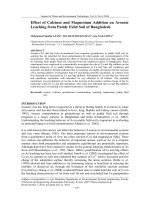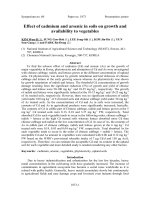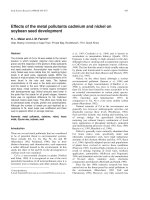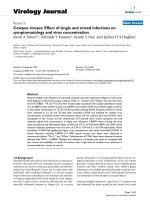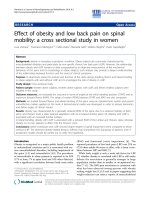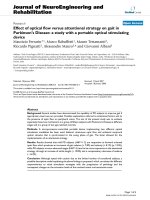Effect of cd and as in soil on growth availability to plant
Bạn đang xem bản rút gọn của tài liệu. Xem và tải ngay bản đầy đủ của tài liệu tại đây (304.22 KB, 9 trang )
Symposium no. 60 Paper no. 1873 Presentation: poster
1873-1
Effect of cadmium and arsenic in soils on growth and
availability to vegetables
KIM Won-Il (1), JUNG Goo-Bok (1), LEE Jong-Sik (1), KIM Jin-Ho (1), YUN
Sun-Gang (1) and PARK Ro-Dong (2)
(1) National Institute of Agricultural Science and Technology (NIAST), Suwon, 441-
707, KOREA
(2) Chonnam National University, Kwangju, 500-757, KOREA
Abstract
To find the adverse effect of cadmium (Cd) and arsenic (As) on the growth of
major vegetables in Korea, phytotoxicity and absorption of Cd and As were investigated
with chinese cabbage, radish, and lettuce grown at the different concentration of upland
soils. Cd phytotoxicity was shown by growth retardation and leaf chlorosis of chinese
cabbage and lettuce at the early growing season whereas As phytotoxicity was shown
by growth retardation of radish and lettuce. The threshold Cd concentrations of growth
damage resulting from the significant reduction (5%) of growth and yield of chinese
cabbage and lettuce were 50-100 mg kg
-1
and 10-25 mg kg
-1
, respectively. The growth
of radish and lettuce were significantly reduced at the 10-15 mg kg
-1
and 10-25 mg kg
-1
of As treated soils, respectively. However, there was no significant reduction of radish
yield under 100 mg kg
-1
of Cd treated soils and chinese cabbage yield under 30 mg kg
-1
of As treated soils. As the concentrations of Cd and As in soils were increased, the
contents of Cd and As in agricultural products were significantly increased, basically.
The contents of Cd in edible part of Chinese cabbage, radish and lettuce grown at the 5
mg kg
-1
Cd treated soils were 0.13, 0.18 and 3.37 mg kg
-1
FW, respectively. Total
absorbed Cd for each vegetable tends to occur in the following order, chinese cabbage >
radish > lettuce at the high Cd treated soils whereas lettuce absorbed more Cd than
chinese cabbage and radish at the low concentration of Cd. In case of As, the contents of
As in edible part of chinese cabbage, radish and lettuce grown at the 6 mg kg
-1
Cd
treated soils were 0.19, 0.03 and 0.04 mg kg
-1
FW, respectively. Total absorbed As for
each vegetable tends to occur in the order of chinese cabbage > radish > lettuce. The
acceptable Cd and As amount in vegetables were calculated with 0.06 and 0.12 mg kg
-1
FW based on the WHO’s provisional tolerable intake of 7 µg Cd/d and 150 µg As/d,
respectively. Therefore, we can estimate the acceptable Cd and As content in the upland
soil for each vegetable and more detailed study is needed considering any other factors.
Keywords: cadmium, arsenic, vegetables, phytotoxicity, upland soils
Introduction
Due to heavy industrialization and urbanization for the last few decades, heavy
metal concentrations in the cultivating soils have gradually increased. The increase of
contaminants in agricultural ecosystem has become a social issue worldwide as it is
related with public health. Generally, heavy metals accumulate slowly but continuously
in agricultural fields and may damage crops and livestock even humans through food
KIM ET AL. 17
th
WCSS, 14-21 August 2002, Thailand
1873-2
chain. International agencies, such as the Food and Agriculture Organization (FAO) and
the World Health Organization (WHO), are currently advocating compliance to
permission criteria of pollutants in agricultural products (Kabata-Pendias and Pendias.
1984; Fergusson. 1990; FAO. 1989).
Arsenic (As) is not essential for plant growth. Because of chemical similarities to
P, As is able to replace P in many cell reaction and shows many harmful toxicity to
plants including wilting of new-cycle leaves and retardation of root and top growth
(Aller et al., 1990). Lee et al. (1986, 1987) extensively reviewed that the behavior of As
in paddy fields and the effects of absorbed As on physiological and ecological aspects
of rice plant. Cadmium (Cd) is not essential for plant growth, too. Cd is chemically
similar to Zn, an essential element. Cd is readily taken up by the roots and translocated
through the plant and accumulated when it presents in available form. Cd is very toxic
to plant at low concentration with reduced photosynthetic rate and plant growth.
Symptoms include chlorosis, necrosis and wilting. Kim et al., (1983) establelished the
threshold level of Cd for damage of rice plant growth. Muramoto et al., (1990) also
reported that root and shoot weights of rice were reduced 32% and 21% by 100 mg kg
-1
Cd.
However, the studies on the effect of vegetable growth by As and Cd were limited
(John, 1972; Sadana and Singh, 1987). Therefore, this study was carried out to find the
adverse effect of As and Cd on the growth of chinese cabbage, radish and lettuce and to
establelish the critical level of elements in chinese cabbage, radish and lettuce.
Materials and Methods
A silty loam soil with low concentrations of As and Cd was used in the experiment.
Physico-chemical properties of the soil were measured by the standard methods of soil
chemical analysis (NIAST, 1988) and were shown in Table 1. Soil was treated with
Na
2
HAsO
4
, to 3, 6, 10, 15, 30 mg kg
-1
of As soil and CdCl
2
·2½H
2
O, to 5, 10, 25, 50,
100 mg kg
-1
of Cd soil. As and Cd were measured by inductively coupled plasma
emission spectroscopy (ICP, GBC Integra XMP). Chinese cabbage (Brassica ampestris
L.), radish (Raphanus sativus L.), and lettuce (Lactuca sativa L.) were selected. Chinese
cabbage and radish were seeded at the early May while lettuce in the middle of May.
All of crops were harvested at the early July, dried, and ground. Fertilizers were applied
to the standard methods of Rural Development Administration in Korea (1989). Total
contents of As and Cd in vegetables were assayed by ICP after wet-acid (HNO
3
: H
2
SO
4
:
HClO
4
= 10: 1: 4) digestion (NIAST, 1988). Experimental data were analyzed using
super ANOVA (Abacus Concepts Inc. CA, 1989) for probability level of F-test.
Table 1 Physico-chermical properties of soil used.
Extractable cation
(cmol
(+)
kg
-1
)
pH
OM
(g kg
-1
)
Avail
P
2
O
5
(mg kg
-1
)
KCaMg
Clay
(%)
As*
(mg kg
-1
)
Cd**
(mg kg
-1
)
5.3 24.0 92 0.2 4.3 0.9 12 0.21 0.10
* 1N-HCl soluble Arsenic
** 0.1N-HCl soluble cadmium
KIM ET AL. 17
th
WCSS, 14-21 August 2002, Thailand
1873-3
Results and Discussion
Damage symptom of vegetables by As and Cd
As phytotoxicity was shown by growth retardation of radish and lettuce whereas Cd
phytotoxicity was shown by growth retardation and leaf chlorosis of Chinese cabbage
and lettuce at the early growing season (Table 2). Relative yields (%) of the edible part
of chinese cabbage, radish, and lettuce grown at the 0, 3, 6, 10, 15, and 30 mg kg
-1
As
treated soils were shown in Figure 1. The growth of radish and lettuce were
significantly reduced at the 10-15 mg kg
-1
and 10-25 mg kg
-1
of As treated soils,
respectively. However, there was no significant reduction of chinese cabbage yield
under 30 mg kg
-1
of As treated soils. As at 30 mg kg
-1
soils was associated with 20% of
reduction in both radish and lettuce yield. However, chinese cabbage did not affect in
fresh weight at the 30 mg kg
-1
As treated soils. It concluded that As concentration
appearing toxicity was widely varied with plant species. Lee et al., (1986, 1987) widely
identified the symptom of As toxicity in rice plants. They reported that rice yields
significantly decreased with increasing soil As levels and the critical As levels in soils
were estimated to be 6.79 mg kg
-1
for loam and 2.75 mg kg
-1
for sandy loam. Aller et al.
(1990) investigated the rice appear to be more sensitive than other plants in experiments
with toxic levels of As. Peterson et al. (1981) also reported that phytotoxicity of As is
strongly affected by the form in which it occurs in soil. Arsenite is more toxic than
arsenate. Therefore, it seemed that more As sensitive rice related with the reduced
paddy soil condition.
Table 2 Phytotoxicity of chinese cabbage, radish, and lettuce on the As and Cd treated
soils.
Contaminants As Cd
Observed symptom
Radish, Lettuce : growth
retardation
Chinese cabbage : chlorosis
in seedling leaves
Soil 10 mg kg
-1
4 mg kg
-1
Phytotoxicity
Conc.*
Solution 0.001 mg L
-1
0.1 mg L
-1
Phytotoxicity symptom*
Wilting of new-cycle
leaves, Retardation of
root and top growth
Chlorosis, necrosis, wilting,
Reduction in growth
*: Screening benchmark concentration for the phytotoxicity of heavy metals collected by the East
Tennessee Technology Park Technical Information Office (Efroymsom, 1997)
In Cd, chlorosis on the edge of chinese cabbage leaves was shown at the 100 mg
kg
-1
Cd concentration in soil during early growing season (Figure 2). As chinese
cabbage was grown, chlorosis disappeared. However, chinese cabbage fresh weight
reductions rose from less than 50% at the same plot (Figures 3and 4). In lettuce, 80%
reduction in the yield after 8 weeks of growth from seed in soil to which 25 mg kg
-1
Cd
treated soil was shown. The threshold Cd concentrations of growth damage resulting
from the significant reduction (5%) of growth and yield of chinese cabbage and lettuce
were 50-100 mg kg
-1
and 10-25 mg kg
-1
, respectively. However, Cd at 100 mg kg
-1
soil
did not affect the radish growth. John et al. (1972) reported the effect of Cd on radish
growth with 30 different surface soils. Root weight and shoot weight was reduced by an
average of 67% and 47% by the addition of 100 mg kg
-1
Cd, respectively. Sadana and
Singh (1987) investigated the effects of Cd added to a loamy sand soil on lettuce.
KIM ET AL. 17
th
WCSS, 14-21 August 2002, Thailand
1873-4
Lettuce growth reduced 23% by the addition of 4 mg kg
-1
Cd. It concluded that radish
was more resistant to Cd than lettuce.
拒
Figure 1 Relative yield of the edible part of Chinese cabbage, radish, and lettuce
grown at the different As treated soils.
Figure 2 Growth damage of Chinese cabbage at the 100 mg kg
-1
Cd concentration in
soil during early growing season.
KIM ET AL. 17
th
WCSS, 14-21 August 2002, Thailand
1873-5
Figure 3 Growth retardation of lettuce at various concentrations of Cd in soil.
Figure 4 Relative yield of the edible part of chinese cabbage, radish, and lettuce grown
at the Cd treated soils.
Contents of As and Cd in edible part of chinese cabbage, radish, and lettuce
The contents of As and Cd in agricultural products were significantly increased as
the concentrations of As and Cd in soils were increased, basically. Table 3 shows that
the contents of As in edible part of chinese cabbage, radish and lettuce grown at the 0, 3,
6, 10, 15, and 30 mg kg
-1
of As treated soils. The contents of As in the edible parts of
chinese cabbage, radish and lettuce were significantly (5%) increased at the 6, 10, and
0
20
40
60
80
100
120
control 5 10 25 50 100
Cd conc.(m
g
/k
g
soil)
Relative yield(%
)
C. Cabbage
Radish
Lettuc e
KIM ET AL. 17
th
WCSS, 14-21 August 2002, Thailand
1873-6
30 mg kg
-1
As treated soils, respectively. Total absorbed As for each vegetable tends to
occur in the order of chinese cabbage > radish > lettuce (Table 4). Lee et al. (1986)
reported that As contents in brown rice were 0.41 and 0.52 mg kg
-1
FW at the 10 mg kg
-1
As treated loam and sandy loam soils, respectively. The contents of As in edible part of
chinese cabbage, radish and lettuce were 0.19, 0.03, and 0.05 mg kg
-1
FW at the 10 mg
kg
-1
As treated soils, respectively. Kabata-Pendias and Pendias (1984) reported that
there was a linear relationship between As content of vegetation and soluble As
concentration in soils and plants take up As passively with the water flow. Therefore, it
seems that rice plants accumulate more As than other vegetables due to higher water
demand.
Table 3 Concentrations of As in chinese cabbage, radish, and lettuce grown at the
different As concentrations in soil.
As conc. (mg kg
-1
F.W.)
Chinese cabbage Radish Lettuce
As conc.
(mg kg
-1
)
Leaves roots leaves
Control 0.12a* 0.012a 0.00a
3 0.15a 0.020ab -
6 0.19b 0.029ab 0.04a
10 0.19b 0.032b 0.05a
15 0.23c 0.057c 0.08a
30 0.22c 0.071d 0.25b
*: within columns, means followed by the same letter are not significantly different at the 0.05
probability level using the F-test
Table 4 Total As uptake in each plant of chinese cabbage, radish, and lettuce grown in
soils of different As concentrations.
Absorbed As conc. (µg plant
-1
)
As conc.
(mg kg
-1
)
Chinese cabbage Radish Lettuce
Control 302 5.1 0
3 322 8.6 -
6 462 10.6 1.5
10 482 14.3 1.9
15 550 20.5 2.9
30 530 20.7 7.1
Table 5 shows that the contents of Cd in edible part of chinese cabbage, radish and
lettuce grown at the 0, 5, 10, 25, 50, and 100 mg kg
-1
of Cd treated soils. The contents
of Cd in edible part of chinese cabbage, radish and lettuce were significantly (5%)
increased at the 5, 25, and 25 mg kg
-1
Cd treated soils, respectively. Total absorbed Cd
for each vegetable tends to occur in the following order, chinese cabbage > radish >
lettuce at the high Cd treated soils whereas lettuce absorbed more Cd than chinese
cabbage and radish at the low concentration of Cd (Table 6). Kim and Kim (1980)
reported that Cd content in brown rice was 0.35 mg kg
-1
FW at the 5 mg kg
-1
Cd treated
soil. The contents of Cd in edible part of chinese cabbage, radish and lettuce were 0.13,
KIM ET AL. 17
th
WCSS, 14-21 August 2002, Thailand
1873-7
0.04, and 3,37 mg kg
-1
FW at the 5 mg kg
-1
Cd treated soils, respectively (Table 5).
With these results, rice plants accumulate more Cd than chinese cabbage and radish
while less Cd than lettuce. Because of the difficulty in obtaining comparable data from
different studies, it is best to give qualitative estimates for the uptake of the heavy
metals by plants. Fergusson (1990) reported that relative uptake of As was high for
chinese cabbage and medium for radish whereas relative uptake of Cd was medium-low
for chinese cabbage, low-medium for radish and high for lettuce. These results were
agreed with above orders, chinese cabbage > radish > lettuce for As and chinese
cabbage > radish > lettuce for Cd.
Table 5 Concentrations of Cd in Chinese cabbage, radish, and lettuce grown at the
different Cd concentrations in soil.
Cd conc. (mg kg
-1
F.W.)
Chinese cabbage Radish Lettuce
Cd conc.
(mg kg
-1
)
leaves roots Leaves roots leaves roots
Control 0.02a* 0.03a 0.05a 0.04a 0.17a 0.10a
5 0.13a 0.45a 0.15a 0.08ab 3.37b 3.20a
10 0.22a 0.93a 0.53a 0.16ab 3.78b 5.96a
25 0.59b 2.96b 1.59b 0.29b 11.32c 15.5b
50 1.03c 4.37bc 3.07c 0.67c 14.29c 12.9b
100 2.56d 6.09c 5.20d 1.08c 20.04d 45.4c
*: within columns, means followed by the same letter are not significantly different at the 0.05
probability level using the F-test
Table 6 Total Cd uptake in each plant of Chinese cabbage, radish, and lettuce grown in
soils of different Cd concentrations.
Absorbed Cd conc. (µg plant
-1
)
Cd conc.
(mg kg
-1
)
Chinese cabbage Radish Lettuce
Control192011
5 99 52 191
10 147 108 240
25 491 269 125
50 833 525 53
100 1,333 837 125
Both PTWI (provisional tolerable weekly intake) and MPL (maximum permissible
level) values were proposed by the FAO/WHO joint codex commission for food safety.
Table 7 shows the theoretical acceptable As and Cd concentrations in the upland soils
with absorption curve. The acceptable As concentrations of upland soils for chinese
cabbage, radish, and lettuce would be 4.2, 39.9, and 7.0 mg kg
-1
, respectively. It means
that the cultivation soil for chinese cabbage and lettuce must consider the concentration
of As because of 6.0 mg kg
-1
of concern level and 15 mg kg
-1
of countermeasure level
for soil contamination designated by ‘Soil Environment Conservation Law’ in Korea
(1996). In case of Cd, the acceptable concentrations of upland soils for chinese cabbage,
radish, and lettuce would be 2.3, 5.9, and 0.3 mg kg
-1
, respectively. Therefore, the
KIM ET AL. 17
th
WCSS, 14-21 August 2002, Thailand
1873-8
cultivation soil for chinese cabbage and lettuce must consider the concentration of Cd,
too.
Table 7 Theoretical acceptable Cd and As concentration in the upland soils their
absorption curve with chinese cabbage, radish, and lettuce.
Index As Cd
PTWI (µg kg
-1
body weight)*
15 7
MPL (mg kg
-1
FW)** 0.12 0.06
Chinese cabbage 4.2 2.3
Radish 39.9 5.9
Acceptable As and Cd concentraton
in soils (mg kg
-1
soil)
Lettuce 7.0 0.3
Concern level (mg kg soil
-1
)*** 6 1.5
Countermeasure level (mg kg soil
-1
)*** 15 4.0
* Provisional Tolerable Weekly Intake proposed by the FAO/WHO joint codex commission.
** Maximum Permissible Levels of pollutants in food by the FAO/WHO joint codex
commission.
*** Concern and countermeasure levels of heavy metals for soil contamination in the
agricultural soils designated by ‘Soil Environment Conservation Law’ in Korea (Minister
of Environment, 1996)
Conclusion
Phytotoxicity and absorption of Cd and As were investigated with chinese cabbage,
radish, and lettuce grown at the different concentration of upland soils. Growth
retardation of radish and lettuce was shown on the As treated soils whereas growth
retardation and leaf chlorosis of chinese cabbage and lettuce was shown at the early
growing season on the Cd treated soils. The threshold Cd concentrations of growth
damage resulting from the significant reduction (5%) of growth and yield of chinese
cabbage and lettuce were 50-100 mg kg
-1
and 10-25 mg kg
-1
, respectively. The growth
of radish and lettuce were significantly reduced at the 10-15 mg kg
-1
and 10-25 mg kg
-1
of As treated soils, respectively. However, there was no significant reduction of radish
yield under 100 mg kg
-1
of Cd treated soils and chinese cabbage yield under 30 mg kg
-1
of As treated soils. As the concentrations of Cd and As in soils were increased, the
contents of Cd and As in agricultural products were significantly increased, basically.
The contents of Cd in the edible parts of chinese cabbage, radish and lettuce grown at
the 5 mg kg
-1
Cd treated soils were 0.13, 0.18 and 3.37 mg kg
-1
FW, respectively. Total
absorbed Cd for each vegetable tends to occur in the following order, chinese cabbage >
radish > lettuce at the high Cd treated soils whereas lettuce absorbed more Cd than
chinese cabbage and radish at the low concentration of Cd. In case of As, the contents of
As in edible part of chinese cabbage, radish and lettuce grown at the 6 mg kg
-1
Cd
treated soils were 0.19, 0.03 and 0.04 mg kg
-1
FW, respectively. Total absorbed As for
each vegetable tends to occur in the order of chinese cabbage > radish > lettuce.
References
Aller, A.J., J.L., Bernal, M.J. del Nozal and L. Deban. 1990. Effects of selected trace
elements on plant growth. J. Sci. Food Agric. 51:447-479.
Efroymsom, R.A., M.E. Will, G.W. Suter II and A.C. Wooten. 1997. Toxicological
benchmarks for screening contaminants of potential concern for effects on
terrestrial plants, ES/ER/TM-85/R3, Oak Ridge National Laboratory.
KIM ET AL. 17
th
WCSS, 14-21 August 2002, Thailand
1873-9
Fergusson, J.E. 1990. The heavy elements. Chemistry, environmental impact and health
effects, Pergamon Press, Oxford.
Gagnon, J., K.A. Haycock, J.M. Roth, D.S.Jr. Feldman, W.F. Finzer, R. Hoffman and J.
Simpson. 1989. SuperANOVA accessible general linear modeling, Abacus
Concepts Inc. CA.
John, M.K., C. Van Laerhoven and H.H. Chuah. 1972. Factors affecting plant uotake
and phytotoxicity of cadmium added to soils. Environ. Sci. Technol. 6(12):1005-
1009.
Kabata-Pendias, A. and H. Pendias. 1984. Trace elements in soils and plants, CRC
Press. Inc. Boca Raton.
Kim, K.S. and B.J. Kim. 1980. Establelishment of crop phytotoxicity benchmark by
pollutant. Annual Report of Agricultural Science Institute.
Kim, K.S., B.Y. Kim and Y.S. Park. 1983. Effect of various cadmium compounds on
the growth and cadmium uptake of paddy rice. Korean J. Environ. Agric. 2(1):6-12.
Lee, M.H., S.K.H.Lim and B.K. Kim. 1986. Behavior of Arsenic in paddy soils and
effects of absorbed arsenic on physiological and ecological characteristic of rice
plant. II. Effect of As treatment on the growth and as uptake of rice plant. Korean J.
Environ. Agric. 5(2):95-100.
Lee, M.H., S.K.H. Lim and B.K. Kim. 1987. Behavior of Arsenic in paddy soils and
effects of absorbed arsenic on physiological and ecological characteristic of rice
plant. IV. Effect of As content in water culture on transpiraton, stomatal resistance
temperature and humidity in the leaves of rice plant. Korean J. Environ. Agric. 6
(2):39-45.
Minister of Environment. 1996. Soil Environment Conservation Act.
Muramoto, S., H. Nishizaki and I. Aoyama. 1990. The critical levels and the maximum
metal uptake for wheat and rice plants whenapplying metal oxides to soil. J.
Environ. Sci. Health, Part B. 25(2):273-80.
NIAST (National Institute of Agricultural Science and Technology). 1988. Methods of
Soil Chemical Analysis.
RDA (Rural Development Administration). 1989. Standard method for vegetable
cultivation.
Sadana, U.S. and B. Singh. 1987. Yield and uptake of cadmium, lead, and zinc by wheat
grown in soil polluted with heavy metals. J. Plant Sci. Res. 3:11-17.
WHO. 1989. Evaluation of certain food additives and contaminants. 33
rd
report of the
joint FAO/WHO expert committee on food additives. Technical report series 776.
